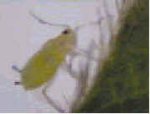

To send a message to an author, click on the author's name at the end of the article.
This Month in Ag Connection | Ag Connection - Other Issues Online
On December 5, 2000, the EPA released its revised risk assessment and announced an agreement with manufactures to phase-out/eliminate certain uses of the organophosphate pesticide diazinon with phase-out completion by 2004.
Alternative pesticides are:
| White Grub | |
|---|---|
| *Imidacloprid: | The product's brand names are Admire, Condifor, Gaucho, Premier, Premise, Provado, and Marathon. |
| *Halofenozide: | The product's brand names are Mach2, Grub-b-gon, and Grubex (interferes with the molting process). |
| *Paenibacillus popillae: | The product's brand name is "Milky Spore Disease" (a bacterial disease for Japanese beetle grubs only). |
| *Trichlorfon: | The product's brand name is Dylox. |
| *Carbaryl: | The product's brand name is Sevin. |
| Caterpillars, Ants, Mole Crickets and Chinch Bugs | |
|---|---|
| *Bacillus thuringiensis (Bt) | Brand names may include Dipel, Javelin, Thuricide, and Bt as a general identifying pesticide abbreviation. Check the label to see if the variety of Bt is recommended to kill caterpillars, beetle larvae (grubs), or fly larvae (maggots and others) and if the particular pest is listed. |
| *Hydramethylnon | Brand names include Amdro and Maxforce. |
| *Abamectin | Brand names include Affirm, Agri-Mek, Avid, Dynamec, Vertimec and Zephyr. |
| Pyrethrins | Natural insecticide from a flower labeled under several brand names. |
| *Pyrethroids | Synthetic insecticides similar to pyrethrins but having greater activity and longevity. Common and brand names may include sumithrin (Anvil), resmethrin (Scourge), and other common and trade names. |
| *Propoxur | There are several brand names of which Baygon is the most common. |
| *Carbaryl | There are other brand names but Sevin is the most common. |
*Please note that these are the names of pesticide (chemical or common names) active ingredients and brand names. There may be many end-use products on the market containing any single active ingredient or combinations of active ingredients. The attached pesticide label is the last word on its use.
(Author: Jim Jarman, Agronomy Specialist)
This Month in Ag Connection | Ag Connection - Other Issues Online

The potential economic losses to Missouri farmers from soybean aphid infestations can be high. In a 2003 Minnesota study, soybean aphids damaged nearly 4 million acres of crops and cost Minnesota farmers about $80 million in damages. While the damages in Minnesota have been high, the economic threshold has been reached in few fields in Missouri.
What sets the soybean aphid apart from other corn and soybean insects is its ability to rapidly reproduce itself asexually -- populations typically double in 2-3 days. The optimum temperature for reproduction has shifted from 78 degrees to 82 degrees, indicating species adaptation to Missouri conditions. One expert described the battle against the tiny green insect as "clone warfare." All soybean-growing areas of Missouri are considered infested.
Management practices should include:
These recommendations are the cooperative effort of researchers throughout the North Central states, funded with soybean checkoff dollars through the North Central Soybean Research Program.
Links to additional information.
(Author: Jim Jarman, Agronomy Specialist)
This Month in Ag Connection | Ag Connection - Other Issues Online

Why is pH important to your crop? A low pH could result in aluminum toxicity (water pH less than 5.5 or a salt pH of less than 5.0), phosphorous (P) less available, slower nitrogen (N) release and reduced effectiveness of triazine herbicides. High pH (> 7.0) can result in carryover of atrazine, Peak, Canopy/Classic, increased nematode populations, and reduced availability of P and micronutrients.
Soil test results from the University of Missouri are reported as salt pH. Most other states and private labs report water pH. Salt pH is closer to the pH that the plant experiences and is more stable and quicker to measure than water pH. Water pH is about 0.5 units higher than salt pH. Different soils have different critical values for pH. Soil pH will affect the nutrient availability to crops. Depending on the soil, the yields will begin to decline at different pH levels. Also, crops respond differently to soil pH level. Forage grasses are the least sensitive to pH levels, followed by wheat, corn, clover, soybean and alfalfa the most sensitive.
Where does acidity originate? The long-term factor is climate. Typically, humid areas have acid soils while arid and semi-arid soils are neutral to alkaline. The short-term cause for acidity is nitrogen fertilizer. Acid is released by conversion of ammonium to nitrate. All N sources are equal in acid formation except for ammonium sulfate, which creates two times more acid. Each pound of N creates enough acidity to require 6 or 7 pounds of lime. In a corn-soybean rotation where an average of 150 pounds of nitrogen is applied each corn production year, you have a total of 600 pounds of N applied in an 8 year period. It will take about 2 tons of lime just to neutralize the acidity from the N fertilizer.
Different soils with the same pH will require different amounts of lime. Clay soils need more lime than loam soils and loam soils need more lime than sandy soils at the same pH. Neutralizable acidity is the lab measurement used to take into account this variability and determine the lime recommendation.
When ordering lime there are some terms that are important. Calcium carbonate equivalence (CCE) is measured on a lime sample by seeing how much acidity it will neutralize per ton in comparison with pure calcium carbonate. The CCE for pure calcium carbonate is 100%. Lime with impurities would be less than 100%. In Missouri, the Effective Neutralizing Material (ENM) is used to describe the effectiveness of the liming material for raising soil pH in the field. ENM = CCE x fineness factor x 800. The fineness factor accounts for how much of the lime will react with soil within 3-4 years.
Additional lime management considerations are needed as producers increase the use of minimum till and no-till. Surface applied N in no-till crop production can result in acidification of the top inch of soil. At low pH levels, atrazine is not as effective, resulting in a potential for weed escapes and increased risk of atrazine carryover. In contrast, surface applications of lime (2 tons for example) can result in high pH in the top inch of soil, and Atrazine carryover risk is increased.
Lime management in no-till or minimum till requires smaller and more frequent applications of lime. The same total amount of lime is still needed. Keep track of soil pH in the top two inches. Sample to two inches and to six inches and keep the samples separate.
(Author: Wayne Crook, Agronomy Specialist)
This Month in Ag Connection | Ag Connection - Other Issues Online
During the estate planning process it is frequently desirable to transfer ownership of assets between the husband and wife. A tax provision known as the marital deduction allows for unlimited transfer of assets to a spouse during life and/or at death without any gift or estate tax liability. A rule specifying the spouse receiving the transfer must be a US citizen or a resident alien is not an obstacle for many people.
(Author: Parman R. Green, Ag Business Specialist)
This Month in Ag Connection | Ag Connection - Other Issues Online
The current price outlook for soybeans makes you wonder whether or not to fertilize soybeans. Fertilizer is usually applied before corn in a corn-soybean rotation. Typically there is no fertilizer applied directly to the soybean crop. This system works as long as there is enough fertilizer applied for both crops.
In 2000 and 2001, University of Missouri researchers conducted soybean fertility trials at 20 sites across the state, to tell if the current recommendations were appropriate. The fertility treatments evaluated included additional N, P, K, sulfur and boron. All sites had adequate nutrient levels, based on the University of Missouri soil test recommendation program.
The scope of this study could not determine if recommendations are too high. However, researchers concluded that recommendations for P and K are at least adequate. If you are following soil test recommendations and your soil nutrients are adequate, additional fertilizer will probably not provide an economic return.
(Author: Wayne Crook, Agronomy Specialist)
This Month in Ag Connection | Ag Connection - Other Issues Online
Publishing Information
Ag Connection is published monthly for Northeast and Central areas of Missouri producers and is supported by the University of Missouri Extension, the Missouri Agricultural Experiment Station, and the MU College of Agriculture, Food and Natural Resources. Managing Editor: Mary Sobba.